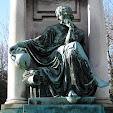
digging a pit in Union Street
In aesthetic terms - not the best ones through which to approach this photo - this is a very dull image, taken through a rather grubby 3rd floor window in my office with a zoom lens; and, in terms of the impact of this digger on my day, it's a very incomplete image without a loud soundtrack of droning engine and the rattle and scrape of the excavator's head in the shaley dark red soil.
We were talking in class about the ethics of photography, and about when we consider it morally permissible to take a picture without someone's consent. A good deal, we concluded, depended on the context, both in which the photo was shot, and the use to which it is put. This image, quite obviously, is in the first instance nothing other than a chance to sound off about the unexpected Noise of today (and tomorrow, and and and...). But if the workmen had seen me taking this, what would they have thought? I can't imagine any plausible explanation (Lisa Henderson's article puts great faith in dialogue with subjects) - "this is for a blog in which I write about photographs?" A phrase which I would have to translate into Spanish - for when I went to inquire, mildly, what they were digging up the vacant lot for, I discovered that was what they spoke. Which could well have raised a whole lot of suspicions: was I from la migra, documenting illegal immigrants, perhaps? Was I an emissary of their employer? So I was hardly going to explain what I was up to: "I collect photographs of mechanical diggers" would have sounded just a little crazy.
I'm currently reading Ariella Azoulay's The Civil Contract of Photography, in which she writes with deep sympathy and ethical scruples about the "ownership" of the photograph: for her, a photograph belongs to no one individual - not to the subject, not to the photographer - but to each one of us: ours to interpret. "The photograph is out there, an object in the world, and anyone, always (at least in principle), can pull at one of its threads and trace it in such a way as to reopen the image and renegotiate what it shows, perhaps even completely overturning what was seen in it before." But this is more than an assertion of the birth of the spectator: she announces the possibilities inherent within a photograph for "injured parties to present their grievances, in person or through others, now or in the future" (p.86). In part, this is because of the apparatus of power that comes into play any time a photograph is taken; more particularly, in her case, her reasoning rests on the subjects about which she writes - above all, Israeli photographs of violent encounters in the Occupied Territories, and images of women, from Muybridge to Abu Ghraib.
So what could be pulled out of this image? The optimistic fact that there is labor in New Brunswick in February 2009? Or other stories, coming from the digger itself, manufactured by the Japanese firm Komatsu, the world's #2 producer of mechanical diggers, and, most depressingly, as they announce on their own website, a "pioneer in the area of mechanized logging" - this razed earth in New Jersey may have its despoliated counterpart out there in southern New Mexico or in Oregon, say. Or one could use the digger, again, to show the precariousness of the economy, despite its current activity: on February 4th, the Chicago Tribune reported that the Komatsu plant in Shawano, WI, was closing - there go the jobs of 95 workers. I think, in other words, that there are a good many intersecting stories of labor to be excavated here, starting with the ironies that could be drawn between these workers' muddy occupation and my own "work" taking and writing about a photograph of them. Azoulay reminds us (p.137) that photographs are the product of work - in claiming my own activity as work, therefore, I'm following her. But there's work, and work - and that. maybe, is one thread to be pulled out of this image.


No comments:
Post a Comment